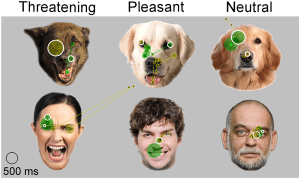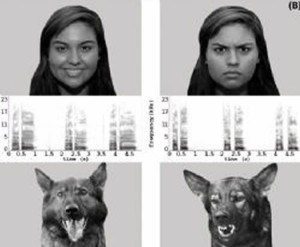Many dog owners can attest that their dogs appear to be “in tune” with their emotions, seeming to intuitively “know” when the owners are feeling depressed or irritable. While in the past plenty of people may have been quick to write this off as anthropomorphism, two recently published studies support the conclusion that it’s true: dogs recognize human emotions.
Scientists from Finland conducted the first study1 we’ll spotlight, analyzing how dogs changed their gaze when looking at photos of humans and other dogs displaying different facial expressions. Depending on the emotion depicted, their gaze would be primarily focused on different parts of the face. The areas focused upon were also influenced by whether they were looking at a human or another dog.
 When viewing images of threatening dogs, it was their mouths that drew the most attention. Additionally, the test-subject dogs spent more time looking at these photos. In the case of threatening humans, however, dogs focused primarily on their eyes, and they generally responded with avoidant behavior.
When viewing images of threatening dogs, it was their mouths that drew the most attention. Additionally, the test-subject dogs spent more time looking at these photos. In the case of threatening humans, however, dogs focused primarily on their eyes, and they generally responded with avoidant behavior.
But why would dogs respond with avoidance to threatening humans, and not threatening dogs? This could be an adaptive behavior brought about through domestication. When dogs were transitioning from wild canines into the companion animals we know today, human breeders likely selected dogs who were not only more submissive by default, but were able to identify when they should be especially submissive (I.e. when a human is threatening them).
“The tolerant behavior strategy of dogs toward humans may partially explain the results. Domestication may have equipped dogs with a sensitivity to detect the threat signals of humans and respond them with pronounced appeasement signals,” says Sanni Somppi, the study’s lead scientist.2
Despite the variability in focus points during the gaze tests, overall, the dogs in the study scanned the entirety of the faces they were viewing, using the full pictures to determine how they perceived the emotions depicted. “This suggests that dogs do not base their perception of facial expressions on the viewing of single structures, but the interpretation of the composition formed by eyes, midface and mouth.”
Many of the same scientists on the team did past research3 that found that dogs can recognize familiar faces in photographs. When shown images of strangers vs. people known to the dogs, the dogs fixated more on the eyes of the familiar faces. The same was true when they were presented with photos of other dogs that they were familiar with. In another experiment4, dogs were even able to recognize that the faces of over 140 different dog breeds were all fellow canines, quite a feat considering that, due to specialized breeding, domestic dogs have the widest morphological variety among all other animal species.
 The second emotion recognition study5 was performed by a team of scientists from the UK and Brazil, and is like the first in that it also examined how dogs responded to images of facial expressions in both humans and other dogs. Where it differs is its inclusion of sound, thereby testing how the dogs reacted to the combination of two different sources of sensory input.
The second emotion recognition study5 was performed by a team of scientists from the UK and Brazil, and is like the first in that it also examined how dogs responded to images of facial expressions in both humans and other dogs. Where it differs is its inclusion of sound, thereby testing how the dogs reacted to the combination of two different sources of sensory input.
Dogs were shown images of dogs and humans exhibiting happy/playful expressions, or angry/aggressive expressions. Paired with these images were sound clips playing vocalizations that were also either happy/playful or angry/aggressive (Ex: A threatening bark from a dog; a threatening verbalization from a human). When the emotions expressed in the sound clips matched the emotions expressed in the images, the test-subject dogs stared for far longer at the images, regardless of whether it was a human or a fellow canine pictured.
These findings suggest that dogs have mental concepts of different emotional states.
“Our study shows that dogs have the ability to integrate two different sources of sensory information into a coherent perception of emotion in both humans and dogs. To do so requires a system of internal categorisation of emotional states. This cognitive ability has until now only been evidenced in primates and the capacity to do this across species only seen in humans.” said Dr. Kun Guo, one of the study’s team members.6
Professor Daniel Mills, another scientist on the team, said:
“It has been a long-standing debate whether dogs can recognise human emotions. Many dog owners report anecdotally that their pets seem highly sensitive to the moods of human family members.
However, there is an important difference between associative behaviour, such as learning to respond appropriately to an angry voice, and recognising a range of very different cues that go together to indicate emotional arousal in another. Our findings are the first to show that dogs truly recognise emotions in humans and other dogs.
Importantly, the dogs in our trials received no prior training or period of familiarisation with the subjects in the images or audio. This suggests that dogs’ ability to combine emotional cues may be intrinsic.”
This article was written by Amanda Pachniewska, founder & editor of Animal Cognition.
Sources
1 – Somppi S, Törnqvist H, Kujala MV, Hänninen L, Krause CM, Vainio O
“Dogs Evaluate Threatening Facial Expressions by Their Biological Validity – Evidence from Gazing Patterns”
PLoS ONE
http://journals.plos.org/plosone/article?id=10.1371/journal.pone.0143047
2 – Emotions matter—dogs view facial expressions differently
Phys.org
http://phys.org/news/2016-01-emotions-matterdogs-view-facial-differently.html
3 – Sanni Somppi, Heini Törnqvist, Laura Hänninen, Christina M. Krause, Outi Vainio
“How dogs scan familiar and inverted faces: an eye movement study”
Animal Cognition
http://link.springer.com/article/10.1007%2Fs10071-013-0713-0
4 – See Spot See
Phys.org
http://phys.org/news/2013-03-see-spot.html
5 – Natalia Albuquerque, Kun Guo, Anna Wilkinson, Carine Savalli, Emma Otta, and Daniel Mills
“Dogs recognize dog and human emotions”
Biology Letters
http://rsbl.royalsocietypublishing.org/content/12/1/20150883
6 – Dogs Able to Recognize Human Emotions
NeuroscienceNews.com
http://neurosciencenews.com/emotion-dogs-psychology-3424/


